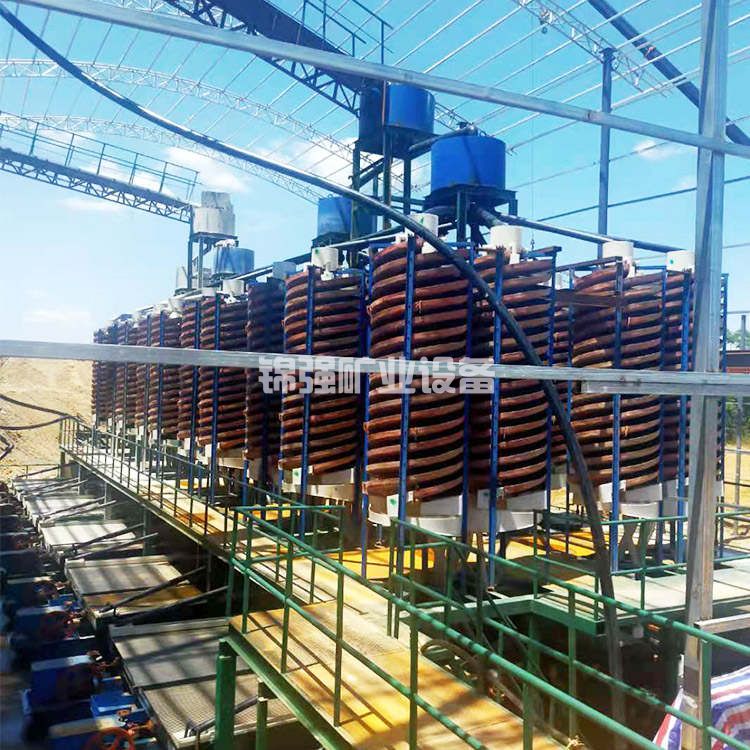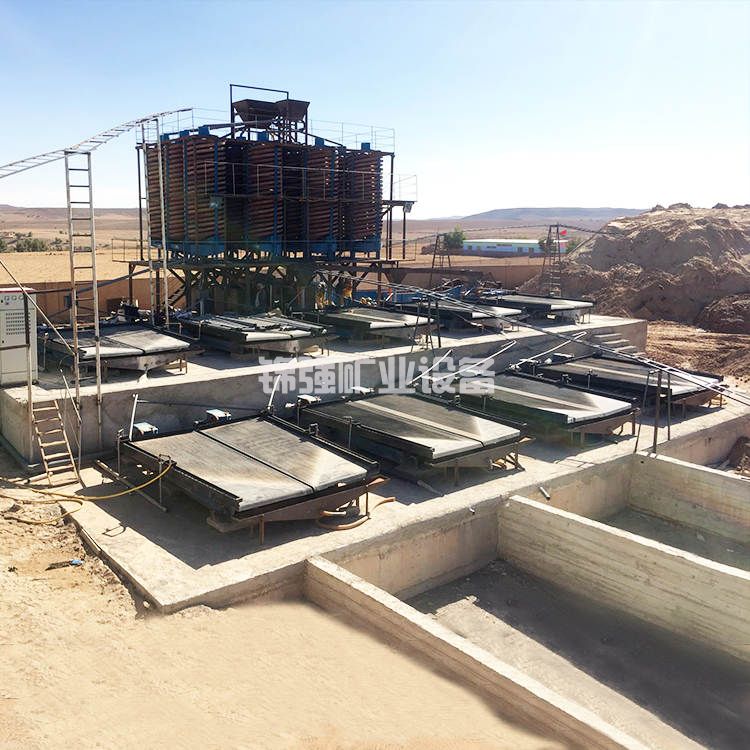The requirements for particle size of spiral chutes indicate that gravity separation is widely used in the beneficiation of metal or non-ferrous metals due to its low environmental pollution and cost. Spiral chute is one of the gravity beneficiation machinery, with a structural feature that the cross-section presents a cubic parabolic shape, suitable for handling finer particle levels of -0.2mm. During the beneficiation process, there is no need to add water for flushing, and the tail of the chute is divided into sections to select fine, medium, and tailings. 2、 Production principle: The spiral mineral separator is not limited to placing on the cross (or tripod) of the support table. The uniform slurry is slowly fed to the rotating groove surface through the feeding groove installed at the head of the spiral groove for sorting. A valve type product selection slot is installed at the tail, allowing the selection equipment to be divided into three (or four) categories according to grade along the radial direction. Adjust the orientation of the valve block to obtain the width of each device. The product gathering bucket is a concentric circular tube that distinguishes and densely draws out the intercepted multi-directional mineral flow. The transverse surface of the fiberglass spiral chute and the slope change of the curve are particularly suitable for the selection of fine particle materials. Requirements for particle size of spiral chutes:  3. Characteristics: 1. Stable and simple sorting steps; 2. Large allowable variation range of feed concentration; 3. High enrichment and recovery rate; 4. Small footprint and water consumption; 5. Simple structure without power; 6. Large production capacity; 7. Easy installation and operation; 8. Small investment and quick effect. Requirements for particle size of spiral chutes:
3. Characteristics: 1. Stable and simple sorting steps; 2. Large allowable variation range of feed concentration; 3. High enrichment and recovery rate; 4. Small footprint and water consumption; 5. Simple structure without power; 6. Large production capacity; 7. Easy installation and operation; 8. Small investment and quick effect. Requirements for particle size of spiral chutes:  4 The structural composition of the spiral chute is composed of six parts: a feeding homogenizer, a feeding chute, a rotating chute, an equipment selection chute, a product gathering hopper, and a support bracket (including a cross or triangular frame). The spiral groove formed by connecting rotating discs is a key accessory. The spiral plate is made of fiberglass (fiberglass reinforced coal gangue), and a wear-resistant layer is pre made on the sorting surface of the rotating groove through bolts. It also has the advantages of lightweight, sturdy, and long-lasting consumer goods. The spiral groove is equipped with a multi tube feeding homogenizer for ore dressing, which is easy to operate. The mineral sorting device is freely placed on the cross (or tripod) of the support table. The evenly divided mineral mortar is slowly fed onto the spiral groove surface through the feeding groove installed at the beginning of the rotating groove for selection. The bottom of the rotating groove is equipped with a valve block type new product acquisition groove, which allows the sorted new products to be divided into three categories (or four categories) of new equipment along the radial direction according to grade. Change the cutting width of each new product by adjusting the orientation of the valve block. The new product gathering bucket is a concentric circular tube that gathers and exports the selected variable mineral flows. The cross section and slope of the curve of the fiberglass chute are particularly suitable for the selection of fine particle materials. The requirements for particle size of spiral chutes are five. The utilization range of spiral concentrators is suitable for processing 0.6-0.03mm or vein ores and minerals, but high mud content is unfavorable for separation. Nowadays, it is widely used for processing iron ore, tungsten, tin, tantalum niobium ore, bay or riverbank ore sand, and gold ore. Requirements for particle size of
4 The structural composition of the spiral chute is composed of six parts: a feeding homogenizer, a feeding chute, a rotating chute, an equipment selection chute, a product gathering hopper, and a support bracket (including a cross or triangular frame). The spiral groove formed by connecting rotating discs is a key accessory. The spiral plate is made of fiberglass (fiberglass reinforced coal gangue), and a wear-resistant layer is pre made on the sorting surface of the rotating groove through bolts. It also has the advantages of lightweight, sturdy, and long-lasting consumer goods. The spiral groove is equipped with a multi tube feeding homogenizer for ore dressing, which is easy to operate. The mineral sorting device is freely placed on the cross (or tripod) of the support table. The evenly divided mineral mortar is slowly fed onto the spiral groove surface through the feeding groove installed at the beginning of the rotating groove for selection. The bottom of the rotating groove is equipped with a valve block type new product acquisition groove, which allows the sorted new products to be divided into three categories (or four categories) of new equipment along the radial direction according to grade. Change the cutting width of each new product by adjusting the orientation of the valve block. The new product gathering bucket is a concentric circular tube that gathers and exports the selected variable mineral flows. The cross section and slope of the curve of the fiberglass chute are particularly suitable for the selection of fine particle materials. The requirements for particle size of spiral chutes are five. The utilization range of spiral concentrators is suitable for processing 0.6-0.03mm or vein ores and minerals, but high mud content is unfavorable for separation. Nowadays, it is widely used for processing iron ore, tungsten, tin, tantalum niobium ore, bay or riverbank ore sand, and gold ore. Requirements for particle size of  spiral chutes
spiral chutes

- Home
- About us
Enterprise Introduction development history Honorary qualifications Technical research and development
 Ganzhou Jinqiang Mining Equipment is a large-scale mining service company specializing in mining machinery manufacturing, mineral analysis, beneficiation process design, equipment selection, and equipment installation and debugging. The company has two large production bases, covering an area of 50000 square meters, with a workshop area of over 20000 square meters. We have 15 years of experience in manufacturing beneficiation equipment. The company's products have all passed ISO9001 and GOST international quality system certification. The gravity beneficiation equipment produced by the company, such as ore dressing shakers, jigs, and spiral chutes, is exported to more than 50 countries worldwide, with customers spread across all continents.
Ganzhou Jinqiang Mining Equipment is a large-scale mining service company specializing in mining machinery manufacturing, mineral analysis, beneficiation process design, equipment selection, and equipment installation and debugging. The company has two large production bases, covering an area of 50000 square meters, with a workshop area of over 20000 square meters. We have 15 years of experience in manufacturing beneficiation equipment. The company's products have all passed ISO9001 and GOST international quality system certification. The gravity beneficiation equipment produced by the company, such as ore dressing shakers, jigs, and spiral chutes, is exported to more than 50 countries worldwide, with customers spread across all continents. - device
Shaker beneficiation equipment Spiral Chute equipment Jig equipment Concentrator equipment Magnetic separator equipment Flotation machine equipment Crusher equipment ball mill Vibrating screen equipment Roller screen equipment Classifier equipment Ore washing machine Sand making machine equipment Sand washing machine equipment
 The company's core business is gravity beneficiation equipment, magnetic separation equipment, ore washing equipment, screening equipment, crushing and grinding equipment, flotation equipment, and mineral conveying equipment. Production of mineral processing equipment, sand gold processing equipment, gold ore processing equipment and Hematite processing equipment and other mineral processing equipment. Our company's gravity beneficiation equipment such as shakers, jigs, and spiral chutes account for 15% of the market share of gravity beneficiation equipment in China.
The company's core business is gravity beneficiation equipment, magnetic separation equipment, ore washing equipment, screening equipment, crushing and grinding equipment, flotation equipment, and mineral conveying equipment. Production of mineral processing equipment, sand gold processing equipment, gold ore processing equipment and Hematite processing equipment and other mineral processing equipment. Our company's gravity beneficiation equipment such as shakers, jigs, and spiral chutes account for 15% of the market share of gravity beneficiation equipment in China. - programme
 The company has a variety of large-scale modern machining equipment, professional mechanical manufacturing engineers, mineral processing engineers, and professional equipment installation team. The company's core business is gravity separation equipment, magnetic separation equipment, ore washing equipment, screening equipment, crushing and grinding equipment, flotation equipment, and mineral conveying equipment. Our company's gravity separation equipment such as ore dressing shakers, jigs, and spiral chutes account for 15% of the market share of gravity separation equipment in China.
The company has a variety of large-scale modern machining equipment, professional mechanical manufacturing engineers, mineral processing engineers, and professional equipment installation team. The company's core business is gravity separation equipment, magnetic separation equipment, ore washing equipment, screening equipment, crushing and grinding equipment, flotation equipment, and mineral conveying equipment. Our company's gravity separation equipment such as ore dressing shakers, jigs, and spiral chutes account for 15% of the market share of gravity separation equipment in China. - news
 The company's core business is gravity separation equipment, magnetic separation equipment, ore washing equipment, screening equipment, crushing and grinding equipment, flotation equipment, and mineral conveying equipment. Production of mineral processing equipment, sand gold processing equipment, gold ore processing equipment and Hematite processing equipment and other mineral processing equipment. Our company's gravity beneficiation equipment such as shakers, jigs, and spiral chutes account for 15% of the market share of gravity beneficiation equipment in China.
The company's core business is gravity separation equipment, magnetic separation equipment, ore washing equipment, screening equipment, crushing and grinding equipment, flotation equipment, and mineral conveying equipment. Production of mineral processing equipment, sand gold processing equipment, gold ore processing equipment and Hematite processing equipment and other mineral processing equipment. Our company's gravity beneficiation equipment such as shakers, jigs, and spiral chutes account for 15% of the market share of gravity beneficiation equipment in China. - contact us
- Home
- About us
- device
- Shaker beneficiation equipment
- Spiral Chute equipment
- Jig equipment
- Concentrator equipment
- Magnetic separator equipment
- Flotation machine equipment
- Crusher equipment
- ball mill
- Vibrating screen equipment
- Roller screen equipment
- Classifier equipment
- Ore washing machine
- Sand making machine equipment
- Sand washing machine equipment
- programme
- news



